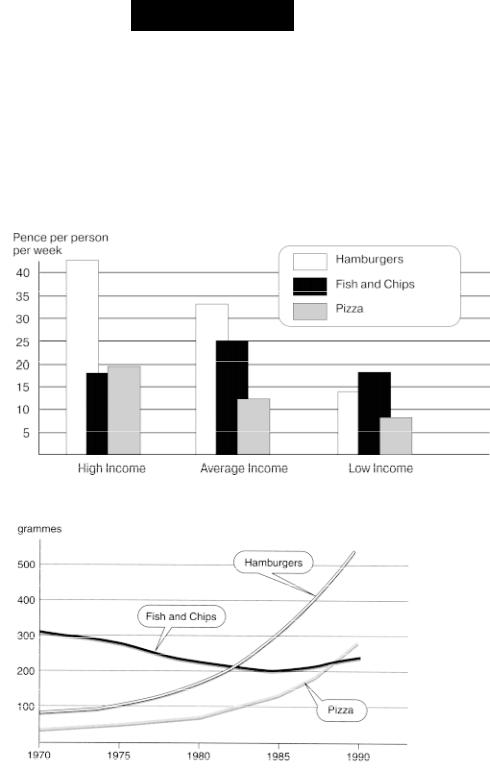
IELTS_
.pdf
similar homes in Britain. "People see this as a way of building for the future." An underground dweller himself, Carpenter has never paid a heating bill, thanks to solar panels and natural insulation.
FIn Europe the obstacle has been conservative local authorities and developers who prefer to ensure quick sales with conventional mass produced housing. But the Dutch development was greeted with undisguised relief by South Limburg planners because of Holland's chronic shortage of land. It was the Tilburg architect Jo Hurkmans who hit on the idea of making use of noise embankments on main roads. His twofloored, four-bedroomed, twobathroomed detached homes are now taking shape. "They are not so much below the earth as in it," he says. "All the light will come through the glass front, which runs from the second floor ceiling to the ground. Areas which do not need much natural lighting are at the back. The living accommodation is to the front so nobody notices that the back is dark."
GIn the US, where energy-efficient homes became popular after the oil crisis of 1973, 10,000 underground houses have been built. A terrace of five homes, Britain's first subterranean development, is under way in Nottinghamshire. Italy's outstanding example of subterranean architecture is the Olivetti residential centre in Ivrea. Commissioned by
Reading
Roberto Olivetti in 1969, it comprises 82 one-bedroomed apartments and 12 maisonettes and forms a house/ hotel for Olivetti employees. It is built into a hill and little can be seen from outside except a glass facade. Patnzia Vallecchi, a resident since 1992, says it is little different from living in a conventional apartment.
HNot everyone adapts so well, and in Japan scientists at the Shimizu Corporation have developed "space creation" systems which mix light, sounds, breezes and scents to stimulate people who spend long periods below ground. Underground offices in Japan are being equipped with "virtual" windows and mirrors, while underground departments in the University of Minnesota have periscopes to reflect views and light.
IBut Frank Siegmund and his family love their hobbit lifestyle. Their home evolved when he dug a cool room for his bakery business in a hill he had created. During a heatwave they took to sleeping there. "We felt at peace and so close to nature," he says. "Gradually I began adding to the rooms. It sounds strange but we are so close to the earth we draw strength from its vibrations. Our children love it; not every child can boast of being watched through their playroom windows by rabbits.
65

Practice Test 3
Questions 13-20
Reading Passage 2 has nine paragraphs (A-I). Choose the most suitable heading for each paragraph from the list of headings below. Write the appropriate numbers (i-xii) in boxes 13
20 on your answer sheet. Paragraph A has been done for you as an example.
NB There are more headings than paragraphs so you will not use all of them.
List of Headings
iA designer describes his houses
iiMost people prefer conventional housing
iiiSimulating a natural environment
ivHow an underground family home developed
vDemands on space and energy are reduced
viThe plans for future homes
viiWorldwide examples of underground living accommodation
viiiSome buildings do not require natural light
ixDeveloping underground services around the world
xUnderground living improves health
xiHomes sold before completion
xiiAn underground home is discovered
Example |
Answer |
Paragraph A |
xii |
|
|
13Paragraph B
14Paragraph C
15Paragraph D
16Paragraph E
17Paragraph F
18Paragraph G
19Paragraph H
20Paragraph I
66
Reading
Questions 21-26
Complete the sentences below with words taken from the reading passage. Use NO MORE
THAN THREE WORDS for each answer. Write your answers in boxes 21-26 on your answer sheet.
21Many developers prefer mass-produced houses because they ...
22The Dutch development was welcomed by ...
23Hurkmans’ houses are built into ...
24The Ivrea centre was developed for ...
25Japanese scientists are helping people ... underground life.
26Frank Siegmund’s first underground room was used for ...
67

Practice Test 3
READING PASSAGE 3
You should spend about 20 minutes on Questions 27-38 which are based on Reading Passage 3 below.
A Workaholic Economy
FOR THE first century or so of the industrial revolution, increased productivity led to decreases in working hours. Employees who had been putting in 12-hour days, six days a week, found their time on the job shrinking to 10 hours daily, then, finally, to eight hours, five days a week. Only a generation ago social planners worried about what people would do with all this new-found free time. In the US, at least, it seems they need not have bothered.
Although the output per hour of work has more than doubled since 1945, leisure seems reserved largely for the unemployed and underemployed. Those who work full-time spend as much time on the job as they did at the end of World War II. In fact, working hours have increased noticeably since 1970 — perhaps because real wages have stagnated since that year. Bookstores now abound with manuals describing how to manage time and cope with stress.
There are several reasons for lost leisure. Since 1979, companies have responded to improvements in the business climate by having employees work overtime rather than by hiring extra personnel, says economist Juliet B. Schor of Harvard University. Indeed, the current economic recovery has gained a certain amount of notoriety for its “jobless” nature:
increased production has been almost entirel} decoupled from employment. Some firms are even downsizing as their profits climb. “All things being equal, we”d be better off spreading around the work,’ observes labour economist Ronald G. Ehrenberg of Cornell University.
Yet a host of factors pushes employers to hire fewer workers for more hours and, at the same time, compels workers to spend more time on the job. Most of those incentives involve what Ehrenberg calls the structure of compensation: quirks in the way salaries and benefits are organised that make it more profitable to ask 40 employees to labour an extra hour each than to hire one more worker to do the same 40-hour job.
Professional and managerial employees supply the most obvious lesson along these lines. Once people are on salary, their cost to a firm is the same whether they spend 35 hours a week in the office or 70. Diminishing returns may eventually set in as overworked employees lose efficiency or leave for more arable pastures. But in the short run, the employer’s incentive is clear.
Even hourly employees receive benefits - such as pension contributions and medical insurance - that are not tied to the number of hours they work. Therefore, it is more
Reprinted with permission. Copyright © 1994 by Scientific American, Inc. All rights reserved.
68

Writing
profitable for employers to work their existing employees harder.
For all that employees complain about long hours, they, too, have reasons not to trade money for leisure. “People who work reduced hours pay a huge penalty in career terms,” Schor maintains. “It”s taken as a negative signal’ about their commitment to the firm.’ [Lotte] Bailyn [of Massachusetts Institute of Technology] adds that many corporate managers find it difficult to measure the contribution of their underlings to a firm’s well-being, so they use the number of hours worked as a proxy for output. “Employees know this,” she says, and they adjust their behavior accordingly.
“Although the image of the good worker is the one whose life belongs to the company,” Bailyn says, “it doesn”t fit the facts.’ She cites both quantitative and qualitative studies that show increased productivity for part-time workers: they make better use of the time they have, and they are less likely to succumb to fatigue in stressful jobs. Companies that employ more workers for less time also gain from the resulting redundancy, she asserts. “The extra people can cover the contingencies that you know are going to happen, such as when
crises take people away from the workplace.’ Positive experiences with reduced hours have begun to change the more-is-better culture at some companies, Schor reports.
Larger firms, in particular, appear to be more willing to experiment with flexible working arrangements...
It may take even more than changes in the financial and cultural structures of employment for workers successfully to trade increased productivity and money for leisure time, Schor contends. She says the U.S. market for goods has become skewed by the assumption of full-time, two-career households. Automobile makers no longer manufacture cheap models, and developers do not build the tiny bungalows that served the first postwar generation of home buyers. Not even the humblest household object is made without a microprocessor. As Schor notes, the situation is a curious inversion of the “appropriate technology” vision that designers have had for developing countries: U.S. goods are appropriate only for high incomes and long hours.
Paul Walluh
69

Practice Test 3
Questions 27-32
Do the following statements agree with the views of the writer in Reading Passage 3? In boxes 27-32 write
YES |
if the statement agrees with the views of the writer |
NO |
if the statement contradicts the views of the writer |
NOT GIVEN |
if it is impossible to say what the writer thinks about this |
|
|
Example |
Answer |
During the industrial revolution people worked harder. NOT GIVEN
27Today, employees are facing a reduction in working hours.
28Social planners have been consulted about US employment figures.
29Salaries have not risen significantly since the 1970s.
30The economic recovery created more jobs.
31Bailyn’s research shows that part-time employees work more efficiently.
32Increased leisure time would benefit two-career households.
Questions 33-34
Choose the appropriate letters A-D and write them in boxes 33 and 34 on your answer sheet.
33 Bailyn argues that it is better for a company to employ more workers because
Ait is easy to make excess staff redundant.
Bcrises occur if you are under-staffed.
Cpeople are available to substitute for absent staff.
Dthey can project a positive image at work.
34Schor thinks it will be difficult for workers in the US to reduce their working hours because
A they would not be able to afford cars or homes.
B employers are offering high incomes for long hours.
C the future is dependent on technological advances.
D they do not wish to return to the humble post-war era.
70

Reading
Questions 35-38
The writer mentions a number of factors that have resulted, in employees working longer hours. Which FOUR of the following factors are mentioned? Write your answers (A-H) in boxes 35-38 on your answer sheet.
List of Factors
ABooks are available to help employees cope with stress.
BExtra work is offered to existing employees.
CIncreased production has led to joblessness.
DBenefits and hours spent on the job are not linked.
EOverworked employees require longer to do their work.
FLonger hours indicate greater commitment to the firm.
GManagers estimate staff productivity in terms of hours worked.
HEmployees value a career more than a family.
71

Practice Test 3
WRITING
WRITING TASK 1
You should spend about 20 minutes on this task
The chart below shows the amount of money per week spent on fast foods in Britain. The graph shows the trends in consumption of fast foods.
Write a report for a university lecturer describing the information shown below.
You should write at least 150 words.
Expenditure on fast foods by income groups
Consumption of fast foods 1970 -1990
72
Writing
WRITING TASK 2
You should spend about 40 minutes on this task.
Present a written argument or case to an educated reader with no specialist knowledge of the following topic:
News editors decide what to broadcast on television and what to print in newspapers. What factors do you think influence these decisions? Do we become used to bad news? Would it be better if more good news was reported?
You should write at least 250 words.
Use your own ideas, knowledge and experience and support your arguments with examples and relevant evidence.
73

Practice Test 3
SPEAKING
CANDIDATE`S CUE CARD
Task 3
THE PUBLIC HOLIDAY
There will soon be a public holiday in the country your examiner comes from. You want to find out about the holiday.
Ask the examiner about: |
the name of the public holiday |
|
the significance of the holiday |
|
availability of services on the day |
|
(banks/shops/cinemas) |
|
things for visitors to do |
|
how she/he plans to spend the day |
INTERVIEWER`S NOTES
THE PUBLIC HOLIDAY
Choose a lesser known public holiday from your country. Be prepared to provide some accurate information on the history and significance of the day. If in-country, tell the candidate how you will spend the day.
If you are in a non-English speaking country, tell the candidate how people normally spend this day back home.
Provide information about the availability of shops, services and banks on the day.
74
